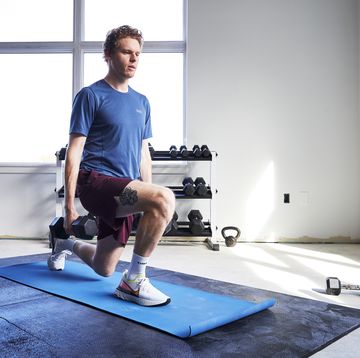You feel the pain of a hard workout instantly, but what about the gain? If you’re wondering how long it takes to see the rewards (reduced running speeds after a round of sprint intervals, increased endurance after a long-run) for your efforts, we have some good news, and some bad news.
We’ll start with the good: “You’ll see some benefits immediately following a hard workout,” says Matt Lee, Ph.D., certified exercise physiologist and a professor of kinesiology at San Francisco State University. The first one to kick in: increased blood volume. “Your blood volume will increase within 24 hours,” he says. “This helps blood flow through your body (and heart!) more efficiently, which may make runs feel easier for the next few days.”
More good news: A tough workout triggers cellular changes that make you faster. A Journal of Applied Physiology study shows that four 30-second, all-out cycling sprints activate certain enzymes associated with mitochondrial density. If you think back to eighth-grade biology, you might remember that the mitochondria is commonly called “the powerhouse of the cell” because of its role in energy production.
“The signaling process to increase mitochondrial density likely begins immediately, although it will take weeks of regular training to see significant increases,” Lee says.
How this translates to the track: “Assuming there’s also an increase in the number of capillaries in the muscle (another perk of exercise), your muscles will uptake more oxygen, and produce more ATP (our usable form of energy).” This may mean a boost in both endurance and speed, he explains. (It’s worth noting that other factors—like your running mechanics and muscle mass—play a role in how fast and far you can run, too.)
[Blast through a series of HIIT sessions to boost running strength and prevent injury with the IronStrength Workout.]
But be warned: This doesn’t mean you should capitalize on these cardio gains with a marathon immediately following a sprint session. “If your workout is more intense than usual, you may have more residual muscle soreness the following day or two,” says Jill Barnes, Ph.D., an assistant professor of kinesiology at the University of Wisconsin-Madison. “Too many back-to-back HIIT workouts without adequate recovery can impair performance and lead to overuse injuries.” Generally speaking, you should give yourself an active recovery day after a super intense workout: a short swim, a yoga class, a light hike.
Join Runner's World+ for unlimited access to the best training tips for runners
Lee agrees, noting that there are things to consider besides cardio when you’re training for a race—namely, injury prevention. “That’s why training programs gradually (and slowly) increase the volume of running and allow for recovery following long runs.”
In fact, the best way to answer the question, “How long does it take to benefit from a hard workout?” is to look at the way most training plans are designed. You always have one long run a week, shorter tempo runs that build up to your long run, and a few low-intensity rest days trickled in between. Lee says this goes back to the principle of overload: “You overload the body, let it adapt, then overload it again,” he says. “It’s a gradual process that snowballs over a few weeks as you get better and better.”
This leads us to the bad news, which really isn’t so bad if you enjoy exercise: You need to work out regularly for real results. “Studies show that it usually takes at least five to 10 HIIT sessions before performance improves,” Barnes says. (Both Lee and Barnes note that when researchers look into the benefits of HIIT, they have their subjects follow a workout plan for two to 12 weeks, exercising three to four times a week.)
That was the case for this recent Journal of Strength and Conditioning Research study, which found that six sprint workouts (three short sessions a week at max intensity for two weeks) improved athletes’ power and speed. The benefits weren’t instant, but you can handle six short workouts for at least two weeks, right?
The bottom line: Your body benefits from small changes almost instantly, and if you stick with it by slowly building up your volume and intensity (keyword: slowly to prevent injury) and allow for adequate recovery, you’ll see big improvements in as little as two weeks. Stick with it for a full twelve weeks, and you might peak just in time for the big race.













